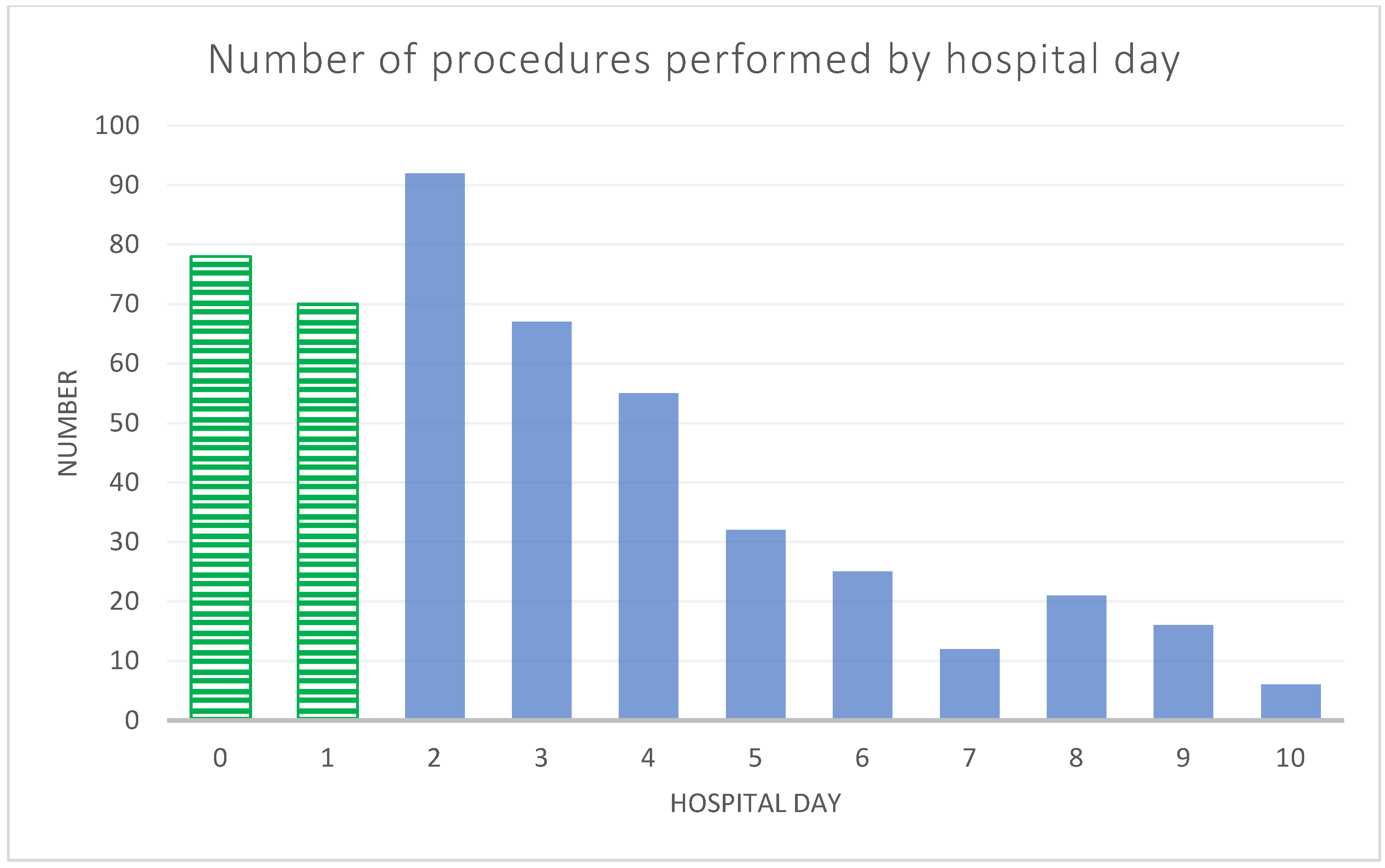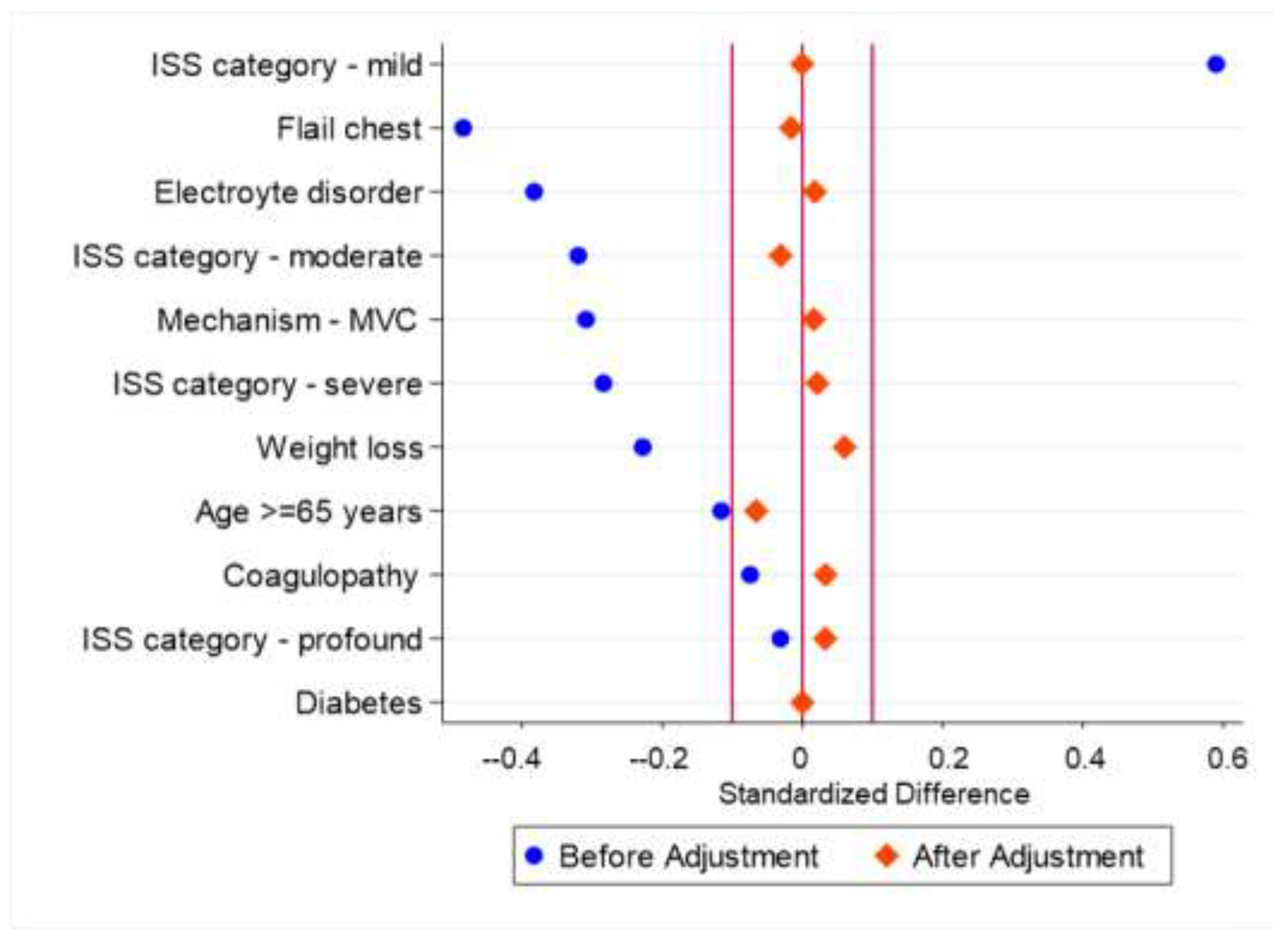Early Repair of Rib Fractures Is Associated with Superior Length of Stay and Total Hospital Cost: A Propensity Matched Analysis of the National Inpatient Sample
Abstract
1. Background
2. Methods
2.1. Data Source
2.2. Study Population
2.3. Outcome Variables
2.4. Statistical Analysis
3. Results
3.1. Multivariable Analysis
3.2. Propensity Matched Analysis
4. Discussion
Limitations
5. Conclusions
Author Contributions
Funding
Institutional Review Board Statement
Informed Consent Statement
Data Availability Statement
Conflicts of Interest
References
- Tanaka, H.; Yukioka, T.; Yamaguti, Y.; Shimizu, S.; Goto, H.; Matsuda, H.; Shimazaki, S. Surgical stabilization of internal pneumatic stabilization? A prospective randomized study of management of severe flail chest patients. J. Trauma 2002, 52, 727–732. [Google Scholar] [CrossRef] [PubMed]
- Kasotakis, G.; Hasenboehler, E.A.; Streib, E.W.; Patel, N.; Patel, M.B.; Alarcon, L.; Bosarge, P.L.; Love, J.; Haut, E.R.; Como, J.J. Operative fixation of rib fractures after blunt trauma: A practice management guideline from the Eastern Association for the Surgery of Trauma. J. Trauma Acute Care Surg. 2017, 82, 618–626. [Google Scholar] [CrossRef] [PubMed]
- Pieracci, F.M.; Leasia, K.; Bauman, Z.; Eriksson, E.A.; Lottenberg, L.; Majercik, S.; Powell, L.; Sarani, B.; Semon, G.; Thomas, B.; et al. A multicenter, prospective, controlled clinical trial of surgical stabilization of rib fractures in patients with severe, nonflail fracture patterns (Chest Wall Injury Society NONFLAIL). J. Trauma Acute Care Surg. 2020, 88, 249–257. [Google Scholar] [CrossRef] [PubMed]
- Simmonds, A.; Smolen, J.; Ciurash, M.; Alexander, K.; Alwatari, Y.; Wolfe, L.; Whelan, J.F.; Bennett, J.; Leichtle, S.W.; Aboutanos, M.B.; et al. Early surgical stabilization of rib fractures for flail chest is associated with improved patient outcomes: An ACS-TQIP review. J. Trauma Acute Care Surg. 2023, 94, 532–537. [Google Scholar] [CrossRef] [PubMed]
- Pieracci, F.M.; Coleman, J.; Ali-Osman, F.; Mangram, A.; Majercik, S.; White, T.W.; Jeremitsky, E.; Doben, A.R. A multicenter evaluation of the optimal timing of surgical stabilization of rib fractures. J. Trauma Acute Care Surg. 2018, 84, 1–10. [Google Scholar] [CrossRef] [PubMed]
- Prins, J.T.H.; Wijffels, M.M.E.; Pieracci, F.M. What is the optimal timing to perform surgical stabilization of rib fractures? J. Thorac. Dis. 2021, 13 (Suppl. S1), S13–S25. [Google Scholar] [CrossRef] [PubMed]
- National Inpatient Sample (NIS). Healthcare Cost and Utilization Project (HCUP) [Internet]. Agency for Healthcare Research and Quality. 2012. Available online: www.hcup-us.ahrq.gov/nisoverview.jsp (accessed on 20 September 2023).
- Elixhauser, A.; Steiner, C.; Harris, D.R.; Coffey, R.M. Comorbidity measures for use with administrative data. Med. Care 1998, 36, 8–27. [Google Scholar] [CrossRef] [PubMed]
- Chu, Y.T.; Ng, Y.Y.; Wu, S.C. Comparison of different comorbidity measures for use with administrative data in predicting short- and long-term mortality. BMC Health Serv. Res. 2010, 10, 140. [Google Scholar] [CrossRef] [PubMed]
- Clark, D.E.; Black, A.W.; Skavdahl, D.H.; Hallagan, L.D. Open-access programs for injury categorization using ICD-9 or ICD-10. Inj Epidemiol. 2018, 5, 11. [Google Scholar] [CrossRef] [PubMed]
- Baker, S.P.; O’Neill, B.; Haddon, W., Jr.; Long, W.B. The injury severity score: A method for describing patients with multiple injuries and evaluating emergency care. J. Trauma 1974, 14, 187–196. [Google Scholar] [CrossRef] [PubMed]
- Bolorunduro, O.B.; Villegas, C.; Oyetunji, T.A.; Haut, E.R.; Stevens, K.A.; Chang, D.C.; Cornwell, E.E., III; Efron, D.T.; Haider, A.H. Validating the Injury Severity Score (ISS) in different populations: ISS predicts mortality better among Hispanics and females. J. Surg. Res. 2011, 166, 40–44. [Google Scholar] [CrossRef] [PubMed]
- Lagazzi, E.; Argandykov, D.; de Roulet, A.; Proaño-Zamudio, J.A.; Romijn, A.C.; Abiad, M.; Rafaqat, W.; Velmahos, G.C.; Hwabejire, J.O.; Paranjape, C.N. Evaluating the Impact of Timing to Rib Fixation in Patients with Traumatic Brain Injury: A Nationwide Analysis. J. Trauma Acute Care Surg. 2023, 95, 846–854. [Google Scholar] [CrossRef] [PubMed]
- Iqbal, H.J.; Alsousou, J.; Shah, S.; Jayatilaka, L.; Scott, S.; Scott, S.; Melling, D. Early Surgical Stabilization of Complex Chest Wall Injuries Improves Short-Term Patient Outcomes. J. Bone Jt. Surg. Am. 2018, 100, 1298–1308. [Google Scholar] [CrossRef] [PubMed]
- Barie, P.S.; Hydo, L.J.; Shou, J.; Larone, D.H.; Eachempati, S.R. Influence of antibiotic therapy on mortality of critical surgical illness caused or complicated by infection. Surg. Infect. 2005, 6, 41–54. [Google Scholar] [CrossRef] [PubMed]


| Category | Early SSRF N = 148 | Late SSRF N = 326 | p-Value | Effect Size (Estimate, 95% Confidence Interval) | |
|---|---|---|---|---|---|
| Age (years) | 55.5 (45–66) | 57 (45–69) | 0.321 | 0.094 (−0.100–0.288) | |
| Female sex | 44 (29.7%) | 80 (29.7%) | 0.234 | −0.118 (−0.312–0.76) | |
| Academic institution | 121 (81.8%) | 285 (87.4%) | 0.103 | 0.161 (−0.032–0.356) | |
| Private insurance | 64 (43.2%) | 123 (37.9%) | 0.266 | −0.110 (−0.304–0.084) | |
| Hypertension | 66 (44.6%) | 144 (44.2%) | 0.932 | −0.008 (−0.202–0.185) | |
| Diabetes | 20 (13.5%) | 44 (13.5%) | 0.996 | −0.040 (−0.232–0.153) | |
| Chronic lung disease | 22 (14.9%) | 44 (13.5%) | 0.690 | −0.039 (−0.233–0.154) | |
| Peripheral vascular disease | 12 (3.7%) | 7 (4.7%) | 0.590 | −0.053 (−0.247–0.140) | |
| Congestive heart failure | 20 (6.1%) | 6 (4.1%) | 0.356 | 0.091 (−0.103–0.285) | |
| Weight loss | 32 (9.8%) | 6 (4.1%) | 0.032 | 0.212 (0.017–0.407) | |
| Coagulopathy | 21 (6.4%) | 6 (4.1%) | 0.464 | 0.072 (−0.121–0.266) | |
| Electrolyte disorder | 26 (17.6%) | 111 (34.1%) | <0.001 | 0.368 (0.172–0.563) | |
| Flail chest | 45 (30.4%) | 175 (53.7%) | <0.001 | 0.477 (0.280–0.673) | |
| Mechanism: MVC | 39 (26.4%) | 133 (40.8%) | 0.002 | 0.302 (0.107–0.497) | |
| Injury severity score | 9 (1–11) | 10 (9–17) | <0.001 | 0.471 (0.275–0.668) | |
| ISS category | Mild | 68 (46.0%) | 63 (19.3%) | <0.001 | −0.671 (−0.815–0.419) |
| Moderate | 57 (38.5%) | 177 (54.3%) | 0.001 | 0.318 (0.122–0.513) | |
| Severe | 15 (10.1%) | 66 (20.3%) | 0.007 | 0.270 (0.074–0.465) | |
| Profound | 8 (5.4%) | 20 (6.1%) | 0.755 | 0.030 (−0.163–0.225) | |
| Category | Adverse Outcome If Factor Present | Adverse Outcome If Factor Absent | p-Value | |
|---|---|---|---|---|
| Early SSRF (vs. late) | 24/148 (16.2%) | 131/326 (40.2%) | <0.001 | |
| Age > 65 years | 57/153 (37.3%) | 110/341 (32.3) | 0.278 | |
| Female sex | 36/126 (28.6%) | 131/368 (35.6%) | 0.150 | |
| Academic institution | 143/422 (33.9%) | 24/72 (33.3%) | 0.927 | |
| Private insurance | 67/196 (34.2%) | 100/297 (33.7%) | 0.906 | |
| Hypertension | 65/213 (30.5%) | 102/281 (36.3%) | 0.178 | |
| Diabetes | 15/65 (23.1%) | 152/429 (35.4%) | 0.050 | |
| Chronic lung disease | 23/67 (34.3%) | 144/427 (33.7%) | 0.923 | |
| Peripheral vascular disease | 6/19 (31.6%) | 161/475 (33.9%) | 0.834 | |
| Congestive heart failure | 12/27(44.4%) | 155/467 (33.2%) | 0.229 | |
| Weight loss | 28/42 (66.7%) | 139/452 (30.8%) | <0.001 | |
| Coagulopathy | 17/30 (56.7%) | 150/464 (32.3%) | 0.006 | |
| Electrolyte disorder | 72/149 (48.3%) | 95/345 (27.5%) | <0.001 | |
| Flail chest | 105/234 (44.9%) | 62/260 (23.9%) | <0.001 | |
| Mechanism: MVC | 79/181 (43.7%) | 88/313 (28.1%) | <0.001 | |
| ISS category | Mild | 17/132 (12.9%) | 150/362 (41.4%) | <0.001 |
| Moderate | 95/243 (39.1%) | 72/251 (28.7%) | 0.014 | |
| Severe | 39/90 (43.3%) | 128/404 (31.7%) | 0.035 | |
| Profound | 16/29 (55.2%) | 151/465 (32.5%) | 0.012 | |
| Covariate | Odds Ratio (OR) | 95% Conf. Interval | p-Value | |
|---|---|---|---|---|
| Early SSRF (vs. late) | 0.43 | 0.21–0.87 | 0.020 | |
| Diabetes | 0.72 | 0.3–1.72 | 0.458 | |
| Weight loss | 3.65 | 1.37–9.71 | 0.010 | |
| Coagulopathy | 2.24 | 0.81–6.25 | 0.121 | |
| Electrolyte disorder | 1.71 | 0.93–3.14 | 0.083 | |
| Flail chest (vs. multiple rib fracture) | 1.48 | 0.88–2.48 | 0.136 | |
| Mechanism: MVC (vs. other) | 1.46 | 0.83–2.56 | 0.191 | |
| ISS category | Mild | ref | - | - |
| Moderate | 2.37 | 1.13–4.99 | 0.023 | |
| Severe | 2.65 | 1.02–6.87 | 0.045 | |
| Profound | 4.85 | 1.33–17.66 | 0.017 | |
| Covariate | Hospital Length of Stay | Total Hospital Charge | |||||
|---|---|---|---|---|---|---|---|
| Coefficient | 95% Conf. Interval | p-Value | Coefficient | 95% Conf. Interval | p-Value | ||
| Early SSRF (vs. late) | −4.67 | −6.54–−2.79 | 0.000 | −45,162 | −91,460–1135 | 0.060 | |
| Diabetes | −1.85 | −3.73–0.03 | 0.050 | −59,860 | −101,318–−18,401 | 0.010 | |
| Weight loss | 7.22 | 2.93–11.52 | 0.000 | 168,451 | 14,942–321,960 | 0.030 | |
| Coagulopathy | 2.83 | −0.68–6.35 | 0.110 | 52,971 | −40,157–146,098 | 0.260 | |
| Electrolyte disorder | 2.46 | 0.36–4.57 | 0.020 | 43,819 | −10,153–97,792 | 0.110 | |
| Flail chest (vs. multiple rib fracture) | 1.52 | −0.41–3.46 | 0.120 | 31,321 | −15,304–77,946 | 0.190 | |
| Mechanism: MVC (vs. other) | 2.66 | 0.71–4.61 | 0.010 | 87,187 | 36,446–137,929 | 0.000 | |
| ISS category | Mild | ref | - | - | ref | - | - |
| Moderate | 0.69 | −1.54–2.92 | 0.540 | 37,641 | −14,083–89,364 | 0.150 | |
| Severe | 2.58 | −0.44–5.6 | 0.090 | 75,453 | 4686–146,219 | 0.040 | |
| Profound | 3.76 | −0.2–7.72 | 0.060 | 70,398 | −42,302–183,097 | 0.220 | |
Disclaimer/Publisher’s Note: The statements, opinions and data contained in all publications are solely those of the individual author(s) and contributor(s) and not of MDPI and/or the editor(s). MDPI and/or the editor(s) disclaim responsibility for any injury to people or property resulting from any ideas, methods, instructions or products referred to in the content. |
© 2024 by the authors. Licensee MDPI, Basel, Switzerland. This article is an open access article distributed under the terms and conditions of the Creative Commons Attribution (CC BY) license (https://creativecommons.org/licenses/by/4.0/).
Share and Cite
Towe, C.W.; Bachman, K.C.; Ho, V.P.; Pieracci, F.; Worrell, S.G.; Moorman, M.L.; Linden, P.A.; Badrinathan, A. Early Repair of Rib Fractures Is Associated with Superior Length of Stay and Total Hospital Cost: A Propensity Matched Analysis of the National Inpatient Sample. Medicina 2024, 60, 153. https://doi.org/10.3390/medicina60010153
Towe CW, Bachman KC, Ho VP, Pieracci F, Worrell SG, Moorman ML, Linden PA, Badrinathan A. Early Repair of Rib Fractures Is Associated with Superior Length of Stay and Total Hospital Cost: A Propensity Matched Analysis of the National Inpatient Sample. Medicina. 2024; 60(1):153. https://doi.org/10.3390/medicina60010153
Chicago/Turabian StyleTowe, Christopher W., Katelynn C. Bachman, Vanessa P. Ho, Fredric Pieracci, Stephanie G. Worrell, Matthew L. Moorman, Philip A. Linden, and Avanti Badrinathan. 2024. "Early Repair of Rib Fractures Is Associated with Superior Length of Stay and Total Hospital Cost: A Propensity Matched Analysis of the National Inpatient Sample" Medicina 60, no. 1: 153. https://doi.org/10.3390/medicina60010153
APA StyleTowe, C. W., Bachman, K. C., Ho, V. P., Pieracci, F., Worrell, S. G., Moorman, M. L., Linden, P. A., & Badrinathan, A. (2024). Early Repair of Rib Fractures Is Associated with Superior Length of Stay and Total Hospital Cost: A Propensity Matched Analysis of the National Inpatient Sample. Medicina, 60(1), 153. https://doi.org/10.3390/medicina60010153







